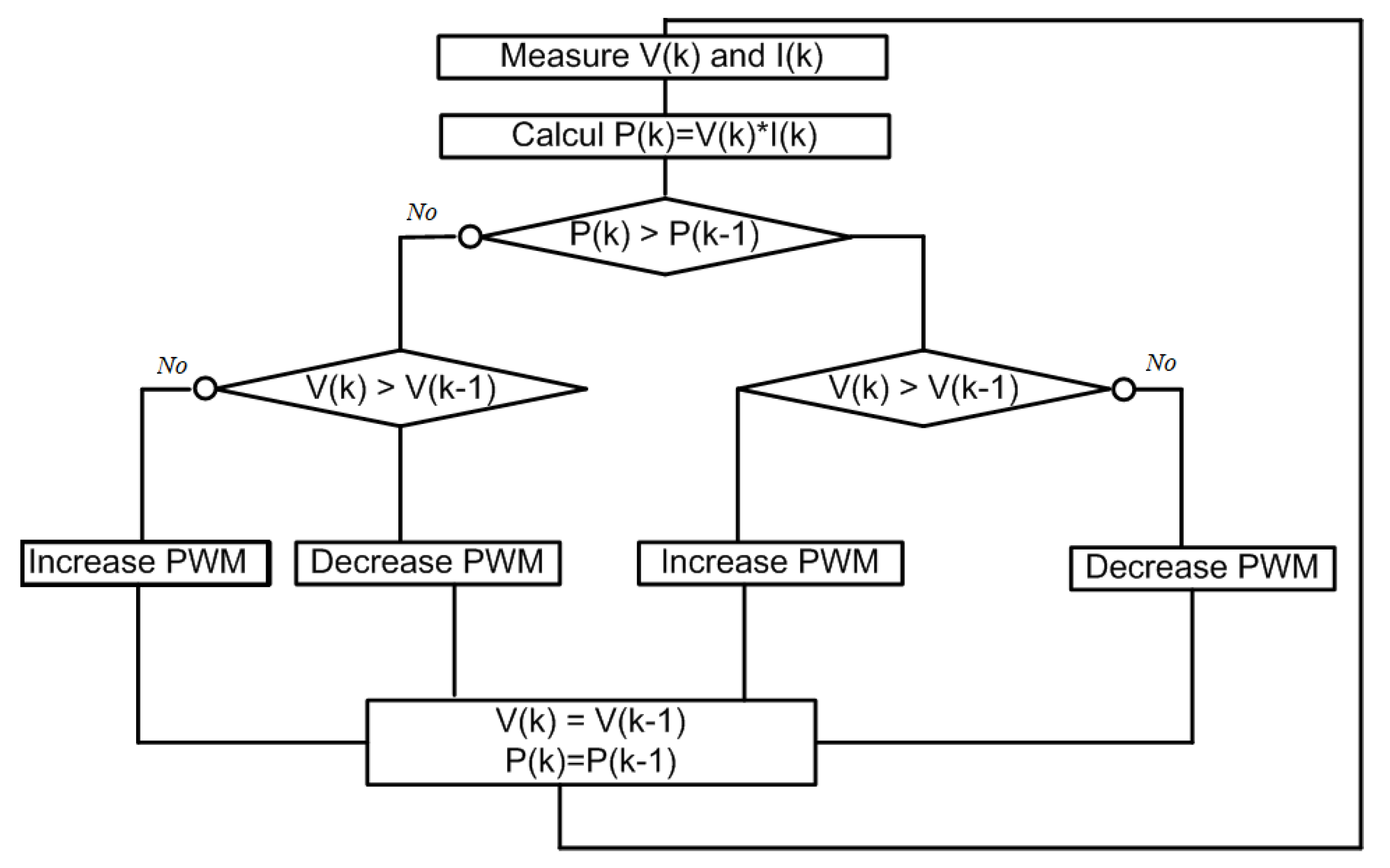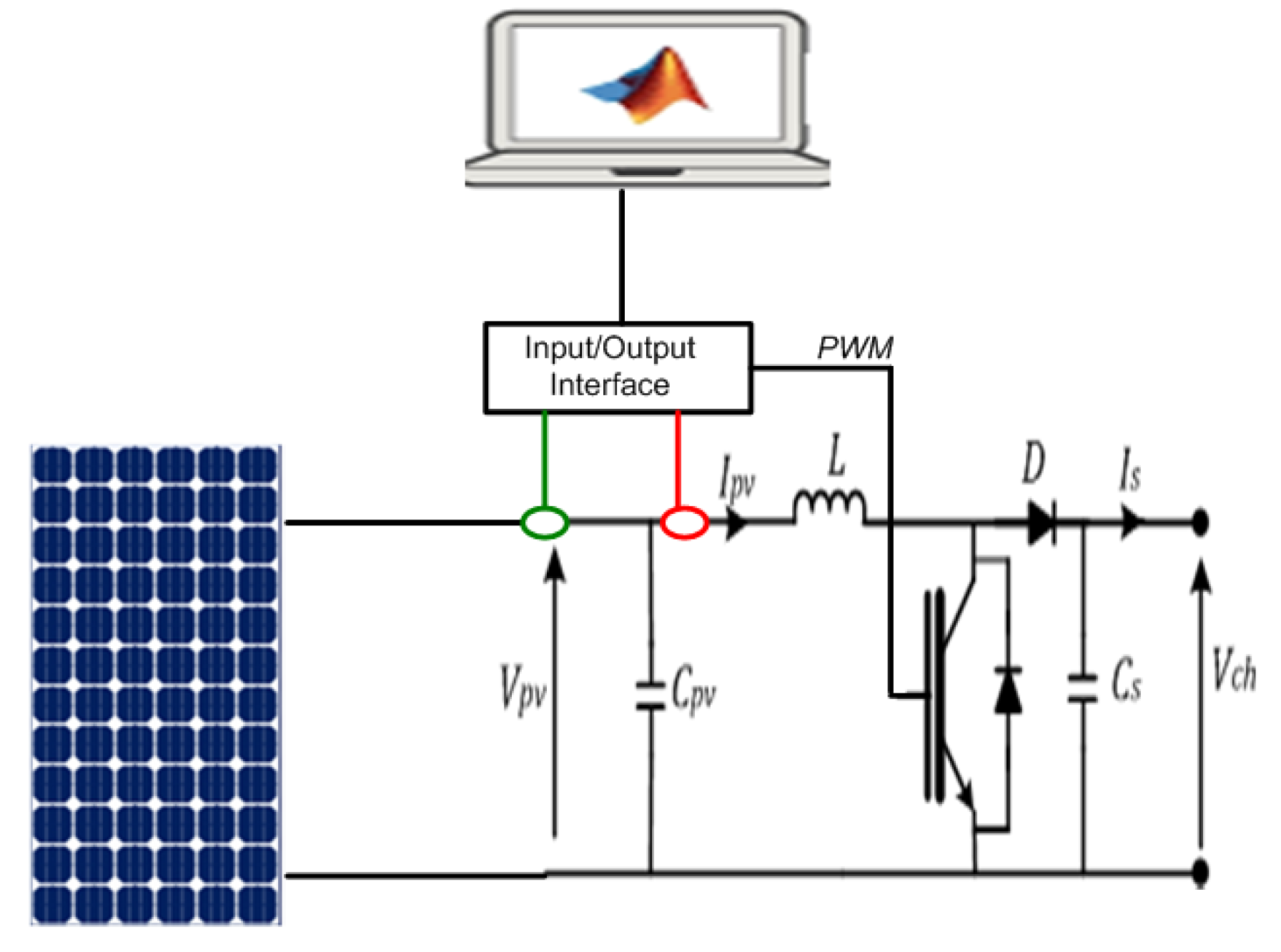1. Introduction
The use of photovoltaic systems has become a popular method of electricity generation because of its certificates, energy freedom, well-known technology, lack of maintenance, and increased efficiency. In addition, photovoltaic systems can generate electricity without moving parts and have a long life compared to other renewable resources. Changes in atmospheric conditions cause the PV system to exhibit nonlinear characteristics. In addition, in all weather conditions, the PV module has a point that can generate the maximum output current and voltage; it is called the maximum power point (MPP).Therefore, it is essential to control the photovoltaic module so that it works under its MPP. The main goal of MPPT is to extract the maximum output power from the photovoltaic modules under different solar rays and temperatures. Several MPPT methods have been developed for photovoltaic systems to achieve MPP, depending on weather conditions and applications, ranging from simple to more complex methods [
1,
2,
3,
4]. Many MPPT methods have been discussed in the literature: the Perturbation and Observation (P&O) method [
2,
5], incremental conductance method (Inc Cond) [
1], the fuzzy logic method [
6,
7], and the neural network method. These methods can be compared by several characteristics: their simplicity, their cost, their convergence efficiency, the application equipment, the number of sensors, etc. [
8].
Yadav et al. [
9] summarized the behavior of MPP under uniform and non-uniform working conditions based on the performance comparison, and selected the best duty cycle of MPPT technology recognized in the industry thanks to its algorithm.
It should also be able to track the global MPP under rapidly changing climatic conditions. In order to track the maximum power point of solar cells under different operating conditions, accurate electronic power equipment should be used. The comparison of industrial methods requires a test bench that allows the study of the effect of changes of climatic conditions, for instance illumination and temperature. Moutchou et al. [
5] are currently studying and simulating a photovoltaic system controlled by the MPPT method based on the INC algorithm to control the DC/DC boost choppers. Moreover, they integrate the control feedback (reverse thrust) in the P&O algorithm to improve the dynamic behavior of the MPP tracking. The implementation of the INC algorithm in the electronic circuit makes it possible to reproduce the real behavior of the photovoltaic system. Furthermore, it allows the study of transient phenomena, and to provide control of the impact on the power oscillation. The results specified in this work should be implemented in practice in order to test the effects of changing climatic conditions, especially temperature and irradiation, on the dynamic behavior of the proposed MPPT method. Yoganandini et al. [
10] propose a new design of MPPT, without using any form of complex design mechanism or including any form of frequently used iterative methods. The proposed model is entirely focused on the development of the algorithm, which uses voltage (open circuit), current (short circuit), and maximum power inputs to obtain the peak power to be extracted from the battery. The proposed system uses the law of diodes, where there is a single diode of junction, current, resistance (in series), solar radiation, and temperature. The proposed system uses solar parameters and temperature as case studies to assess MPPT scores. The results of the method proposed by this work are proven only by the simulation of the model of the photovoltaic cell. Their findings are not implemented in practice to take into account the changes of real surroundings conditions such as the variation in irradiation and temperature in order to validate their dynamic response. MPP point tracking. Abayomi et al. [
1] presented a simulation of a PV system connected to the distribution network supplying a variable load. It is also controlled by an incremental conductance algorithm (indCond) under various weather conditions that vary rapidly. In order to demonstrate the efficiency of the proposed method, the authors tested the PV system for both cases where the surplus or shortage of the generated power occurs. The authors did not present other methods of controlling the PV system and managing the excess power in order to compare them—for example, the method of the ANN neural network allows the management of the PV system according to the meteorological conditions. Obaidulah et al. [
2] presented the MPPT control based on the predictive P&O algorithm. They compared the results of the behavior of the system with the method of the classical P&O algorithm under optimum conditions in order to minimize fluctuations in the power generated by the PV system. The comparative study of the predictive P&O method should also be done with other MPPT methods based on an incremental conductance algorithm or network of neurons ANN. In order to highlight their advantages and disadvantages of operation and study the characteristics such as speed, stability, and precision (fluctuation), this comparison should be performed. Elahi et al. [
11] presented a study for the identification of the operating conditions of the PV system as well as the effect of the variations of irradiation and charges by applying a comparative analysis of the P&O algorithm, the PSO algorithm, the GWO algorithm, the FPA algorithm, and the ChOA algorithm. The performance comparison of the different techniques have proved the robustness of the ChOA method under the considered operating conditions. However, the effectiveness of the studied techniques under real operating conditions such as the change of insolation and the variation of the charges are not considered in this work.
This research, which compares the five MPPT algorithms under specific operating conditions, may be exploited and utilized as decision-making tools, ensuring that the right algorithm is chosen for the right application. Moreover, this comparative study allows the examination of the dynamic responses (electrical quantities Ppv, Vpv, and Ipv) while the complexity of implementation of each algorithm is taken into account.
In this research, five MPPT algorithms are proposed and compared in different atmospheric conditions: P&O method [
2], IncCond method [
1], a method based on the neural network ANN [
12], the method based on the open-circuit voltage and neural network FVCO, and the method based on the short circuit current and FCC neural network. These algorithms are widely used in photovoltaic systems because they are easily implemented. This paper is made up of four parts: the first describes the PV system, the PV model, and the DC/DC converter, the second part presents the declared MPPT algorithms, the third part focuses on the implementation of the system energy and the implementation of commands in the MATLAB/SIMULINK environment, and the last part of the study presents performance and practical results.
6. Conclusions and Perspectives
This article presents the model of the photovoltaic generator which uses different MPP tracking algorithms under different weather conditions in order to compare the behavior of the system (a photovoltaic panel and DC/DC converter).
Moreover, it was found that the FCC algorithm presents an oscillation solution with 1 s duration. As a conclusion, the choice of the appropriate algorithm to apply depends on the required speed and precision. This study was based on a realistic implementation to simulate the performance of these algorithms under real operating conditions.
As perspectives, the proposed algorithms will be implemented in control cards STM 32 of hybrid system converters to improve their performance compared to the application of conventional methods. Moreover, the reliability of these techniques will be tested under real weather conditions that highly affect the PV system performance. Furthermore, in future, the model will be improved by implementing the economic parameters so that the cost-effective technical study will be taken into account during algorithms comparison. In addition, we will study the efficiency of the injection of the power in the network by applying the proposed techniques.
























